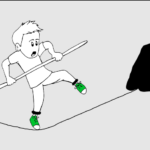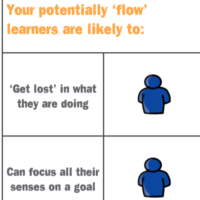Coming back to school after the most difficult lockdown yet, many children – however glad they will be at seeing their friends again – will have become disconnected from their former patterns of learning.
Even the keenest are likely to have lost their edge of concentration; others, perhaps many, will be feeling adrift and maybe unwilling to learn. Signs of stress such as anxiety, recklessness, depression, self-doubt, are likely to show themselves and learning for many will have become a challenge – their Resilience a casualty of lockdown.
We know from research that Resilience is the foundation of emotional tolerance and that without resilience, in one form or another, learning is impossible. The continuing engagement which learning requires can be dangerous. When a child chooses not to learn, it’s because they don’t feel safe enough, or, they think they don’t have the skills, or, there isn’t enough time, or, they might have to give up something else, which they would rather not, or, it simply doesn’t matter enough. You can’t just explain this disinclination as ‘lazy’ or ‘unmotivated’ – there’s far more to this subtle psychological process than that. A child’s urge to withdraw and protect themselves becomes strong and it’s in these sorts of circumstances that emotions arise and students react in different ways.
Getting a handle on self-regulation
It’s useful, in the interests of emotional self management (self-regulation), for teachers and learners to be able to spot and understand when they move from learning mode to protection mode.
For example in protection mode learners may;
 Face down the threat
Face down the threat
One response to distress in the classroom you might see is regression. Students may just give up any attempt to learn and just say ‘ I can’t do that. You do it for me’ expecting that you will just tell them or do it for them in the end. In these circumstances the learner is getting other people to offer them comfort and fight their battles for them.
Not try
Other children may just stop trying and withdraw their effort in order to save face and ensure they fail. In this case they feel if they don’t really try they can’t be labelled ‘stupid’ when they fail. A quick way to counter this is to describe the tasks as ‘very difficult’ so giving pupils a ready made explanation for their possible failure hence their self esteem isn’t threatened and they are free to try as hard as they like.
Become unnoticeable
There are some children that may not display the signs of distress or apprehension but will flee in a different way by becoming unnoticeable. They are sometimes described as the ‘invisible children’ – those who manage to go through school without attracting anyone’s attention; the ones whose names you may forget, are a group who are never disruptive or difficult. The invisible children will have just as many difficulties to overcome but because they have learned how to hide will require a teacher’s keen observation skills to find them and gently address their problems.
Whereas learning mode often takes place close to where challenge can/may tip into threat.
Finding a tipping point
 It’s important that learners understand the power and value of emotions in the context of learning and develop ways of weighing up the risks accurately so they engage with the ones that are safe enough and worthwhile enough, and avoid those that are genuinely dangerous. As learners gain understanding they will develop an increasing ability to tolerate and manage these inevitable feelings of learning.
It’s important that learners understand the power and value of emotions in the context of learning and develop ways of weighing up the risks accurately so they engage with the ones that are safe enough and worthwhile enough, and avoid those that are genuinely dangerous. As learners gain understanding they will develop an increasing ability to tolerate and manage these inevitable feelings of learning.
But what’s the ultimate learning experience?
Being absorbed or in a state of flow is when learners;
- become immersed and engrossed in what they are doing
- are often unaware of the passing of time
- find learning satisfying and rewarding
- relish the feeling of being stretched in their learning
- gain a sense of accomplishment
This state of flow is achieved when there’s a good match between the learner’s motivation, their learning behaviours and the demands of the task, so that it leaves no room left over to feel self conscious or even concerned about success or failure. Flow is accompanied by a feeling of total concentration, and even excitement and can occur in any activity when (1) optimal interest, (2) skill and (3) the intrinsic challenge of the activity itself meet.
Where learning becomes an imposition, as will have happened in some home learning situations, it squashes the excitement of mastering new skills. By providing a culture that allows students to replicate the self propelling features of learning found in early childhood, even if it’s only for a couple of weeks at the end of lock-down, it will help strengthen or re-secure your students’ habits of becoming absorbed.
To achieve positive in flow experiences allow, and enable, learners to:
- make choices – of activities, within activities, when activities are completed;
- make their own goals;
- be involved in planning how they proceed;
- control their attention, noticing and listening carefully;
- review their experience;
- offer commentary on their learning;
- evaluate the end product;
- be motivated by internal incentives.
Spot the features of being absorbed in your learners
Have a quick think about ‘absorbed learners you may know’. Make a note of students you know who display these characteristics.
Developing students’ learning power involves developing a keen awareness of the subtleties of your students’ learning behaviours.
Staying intelligently engaged with learning challenges that matter to you, despite difficulties and setbacks, is perhaps the most important quality of a good learner. Life at present is consumed with extreme and unforeseen difficulties but it’s the ability to bounce back that is crucial.
To give every school a helping hand we have pulled together the best of what we know from schools’ approaches to building resilience and developed an online resource to help every teacher in any primary school (you don’t need to be a ‘BLP school’ to benefit from this resource) to re-energise, re-engage and re-establish students’ resilience as they begin their long journey back to school life.
Find out more about rebuilding your students emotional capacity for learning…
By Maryl Chambers Director Development for TLO.
 Maryl Chambers has spearheaded the development of TLO Limited’s Building Learning Power programmes, helping bring Guy Claxton’s ground-breaking work to schools and teachers. Maryl is one of the founders of TLO, where she has applied her wide experience of designing learning-focused training to creating and developing the innovative programmes for which the company is renowned. She is co-author of many of TLO’s publications and is responsible for creating and writing the Building Learning Power on-line courses.
Maryl Chambers has spearheaded the development of TLO Limited’s Building Learning Power programmes, helping bring Guy Claxton’s ground-breaking work to schools and teachers. Maryl is one of the founders of TLO, where she has applied her wide experience of designing learning-focused training to creating and developing the innovative programmes for which the company is renowned. She is co-author of many of TLO’s publications and is responsible for creating and writing the Building Learning Power on-line courses.


 Face down the threat
Face down the threat
No comments yet.